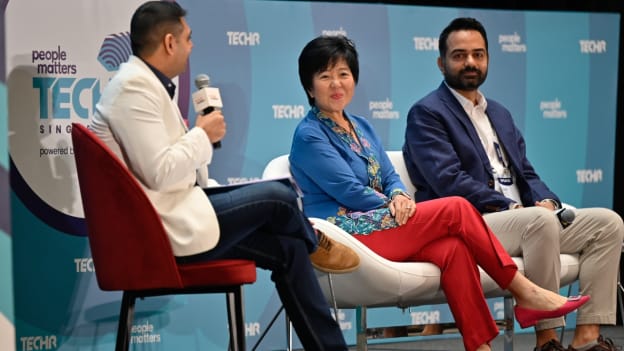What’s your organisational frame of reference for innovation?

Corporate culture is a dynamic force that shapes the way employees work, collaborate, and innovate. So how do you architect a culture that serves as an engine of innovation and business growth?
At TechHR Singapore 2023, a power session on disrupting corporate culture brought to the forefront valuable insights from industry experts Low Peck Kem, the CHRO & Advisor (Workforce Development) of Singapore’s Public Service Division, and Sunil Setlur, the former CHRO of Gojek.
“An organisational culture must be adaptable or open to change because change is the only constant and HR practitioners have a vital role in creating and shaping the workplace culture,” said Low.
An agile workplace, she explained, is where enough support is provided to handhold people through their journey to make it very pleasant.
But don’t handholding and innovation seem like direct opposites? There is a place where the two meet, said the speakers.
“It's about frames of reference. What is your frame of reference as an organisation and as a culture?” said Sunil.
“All of these things fit into that frame of reference. What mindset do you need and how much information do you need? And yes, that's a choice. You can choose to be in a non-innovative environment because that may be right for your business model,” he added.
According to Sunil, it is important for us to help people switch through these frames of reference. How do we help people adopt a frame of reference for when the situation changes? What is the process we will take them through to change their frame of reference and change their context is important,” Sunil explained.
As an organisation changes its frame of reference, different things become important. So, inclusion may be important at one point, while mental health becomes important at another, and at yet another point innovation will take centre stage.
“It is important to note here that one size fits all can not be implemented everywhere. The frames of reference vary from industry to industry, and the stage of the company whether it is a new or well-established company.”
According to Sunil, an earlier-stage company may focus more on speed, getting things done on time. They might not be bothered by hierarchy or formality. On the other hand, large organisations have more to lose in terms of customer trust or value to shareholders. So they optimise for quality, predictability, and customer experience. Navigating through this situation and finding their frame of reference has a big role in shaping the culture of an organisation.
Here are some critical elements and takeaways from the discussion:
Mindset transformation: One of the most crucial elements of culture transformation is mindset change. An organisation needs to instill a growth mindset among its employees. This mindset encourages them to embrace change, take calculated risks, and continuously seek improvement. It's about creating a culture where employees are not afraid to fail but are encouraged to learn from failures and iterate.
Agility: Agility is the ability to adapt quickly to changing circumstances. An agile culture enables organisations to respond to market shifts, customer needs, and emerging technologies effectively. To instill agility, leaders must encourage a flexible, responsive, and learning-oriented environment.
Diversity and inclusion: Embracing diversity and fostering an inclusive culture is essential for innovation. Diverse teams bring varied perspectives and ideas, which can lead to creative solutions. Inclusion ensures that all voices are heard and valued, creating a fertile ground for innovation.
Hierarchy reimagined: Traditional hierarchical structures can stifle innovation. Many organisations are re-evaluating their hierarchies to create flatter, more collaborative structures. Empowering employees at all levels to contribute ideas and make decisions can lead to a more innovative culture.
Rewards and recognition: Aligning rewards and recognition with innovation efforts is crucial. Recognising and celebrating innovative ideas and efforts motivates employees to continue innovating. Reward systems should encourage experimentation and risk-taking.
Measurement and data: While culture is challenging to measure directly, organisations can use data and analytics to track key cultural indicators. Regular surveys and feedback mechanisms can help gauge employee sentiment and identify areas for improvement. Metrics can provide valuable insights into culture's impact on innovation and growth.
Contextual framing: Recognise that different stages of a company's growth may require different cultural emphases. Startups may prioritize speed and experimentation, while more established companies may prioritize stability and consistency. The culture should align with the organization's growth stage and strategic objectives.
Inclusive design: Designing an inclusive culture is becoming increasingly important, especially in aging populations like Singapore. Consider how to tap into the expertise and experience of older workers and create environments that accommodate diverse cohorts of employees.
Continuous learning: Encourage a culture of continuous learning and development. Invest in employee training and upskilling to keep pace with evolving industry trends and technologies.
Intrapreneurship: Large organisations can create intrapreneurship programs to foster innovation within the company. “These programs allow employees to explore innovative ideas in a controlled environment, reducing the risk associated with disruptive change,” said Sunil.
Building a culture of constant innovation and business growth requires a holistic approach that involves mindset transformation, agility, diversity and inclusion, and a willingness to adapt to changing contexts. “Measurement and data-driven insights are essential for monitoring progress and making informed cultural adjustments. By reimagining traditional hierarchies, embracing diversity, and encouraging continuous learning, organisations can thrive in today's dynamic business environment,” said Sunil.
Ultimately, though, the success of an organisation’s culture comes from the buy-in of the people. As Low emphasised, culture transformation is an ongoing process, and it requires commitment from leadership, employees, and all stakeholders. “With the right cultural foundations in place, organisations can position themselves as engines of innovation and growth in their respective industries,” she added.
















